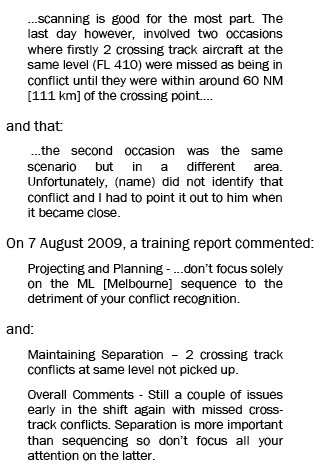Will today’s ATSB report on gross incompetence in AirServices Australia lead to any action over the training and standards crisis in air traffic control in this country?
Probably not. But the ATSB has produced a by-the-second account of how an inadequately trained and supervised air traffic controller failed to separate an Emirates Boeing 777 with 293 persons on board from a Qantas Boeing 737-800 with 150 persons on board and came close to killing a combined total of 443 persons 60 kilometres south-east of Mildura on September 3 last year.
The Qantas flight was tracking east to west from Sydney to Adelaide. The Emirates flight was tracking SSE to NNW from Melbourne to Singapore. Two jets. One newly minted, but inadequately trained and inexperienced controller.
This is the timeline in the ATSB report:
On first contact with the controller at 1841 the crew of the 777 reported they were on climb to 30,000 feet. The controller acknowledged the crew’s transmission, but did not observe the conflict with the 737.
1846: When the controller completed the owards coordination for the 777 he again didn’t observe the pending conflict with the 737.
1858: The controller completed the onwards coordination for the 737, when the aircraft were now less than 10 nautical miles (19 km) apart at the same level and closing. The controller did not notice the reducing proximity of the two aircraft.
1859 +11 seconds: The short term conflict alert activates on the controller’s air situation display, warning him of the pending conflict. The STCA is a collision avoidance tool designed to assist in the identification of potential collisions in radar controlled and surveillance airspace.
Reacting to the alert, the controller instructed the 777 crew to turn right and descend to 29,000 feet. There was no response.
1859+26 seconds: Fifteen seconds later the controller again instructed the 777 crew to take the evasive action. There was no response.
1859+ 44 seconds: The controller was then interrupted by another controller, who was coordinating the movement of another aircraft, before he attempted a third call to the crew of the 777, 18 seconds after the second call.
1859+51 seconds: The controller instructed the crew of the 737 to take evasive action. The crew acknowledged the instruction and turned their aircraft.
1859+56 seconds: Less than five seconds later the radar separation standard of 5 nautical miles (9.3 km)horizontal or 1000 feet vertical was infringed when it reduced to 4.9 nautical miles.
(The crew of the 737 had heard the controller attempt to call the 777 and observed it as a target on their traffic alert and collision avoidance system or TCAS when it indicated the intruder was about 10 nautical miles away at the 1030 o’clock position and closing. Each jet was probably travelling at around 15 kilometres a minute, or 250 metres per second.)
1900+5 seconds: The controller then instructed the 737 crew to climb to 31,000 feet, 54 seconds after the alert first appeared on his screen. Radar separation reduced to 3.6 nautical miles before the 737 reported vertical separation had been achieved by maintaining 31,000 feet at 1901+1 seconds.
1902+36 seconds: The controller handed over to a relieving controller and was stood down.
The ATSB report notes that the controller did not issue a safety alert in the form required to the pilots of either airliner at any time. It notes that his instructions to the Emirates 777 call sign was ‘not clear and distinct’.
It further notes that he engaged in routine coordination with another controller regarding less critical traffic and did not assign priority to two passenger airlines that were rapidly approaching the same place in the sky.
But this comedy of incompetency gets worse.
The ATSB examined the controller’s ATC training records and found that they reported an ‘inability to provide separation assurance during the middle of his on-the-job learning phase.

It also reveals that he had been incompetent earlier in the same day, and temporarily had his air traffic direction ‘privileges’ suspended and then reinstated.

The report says that the ATSB is satisfied with the actions taken by AirServices Australia to remedy the situation. Readers should consider the unusually blunt language of the entire report in assessing that comment.
The quality of training and the availability and retention of skilled air traffic controllers in AirServices Australia is something that the Minister can deal with now, or in a future Royal Commission.
It is his watch, and this incident is but one of at least three significant air traffic control failures in radar controlled air space in recent times, the others involving a Virgin Blue Boeing 737 and a Cathay Pacific A330 near Darwin on December 22 last year and a more recent incident involving a Tiger Airways A320 and a Qantas Boeing 767-300 over Tamworth.







Crikey is committed to hosting lively discussions. Help us keep the conversation useful, interesting and welcoming. We aim to publish comments quickly in the interest of promoting robust conversation, but we’re a small team and we deploy filters to protect against legal risk. Occasionally your comment may be held up while we review, but we’re working as fast as we can to keep the conversation rolling.
The Crikey comment section is members-only content. Please subscribe to leave a comment.
The Crikey comment section is members-only content. Please login to leave a comment.